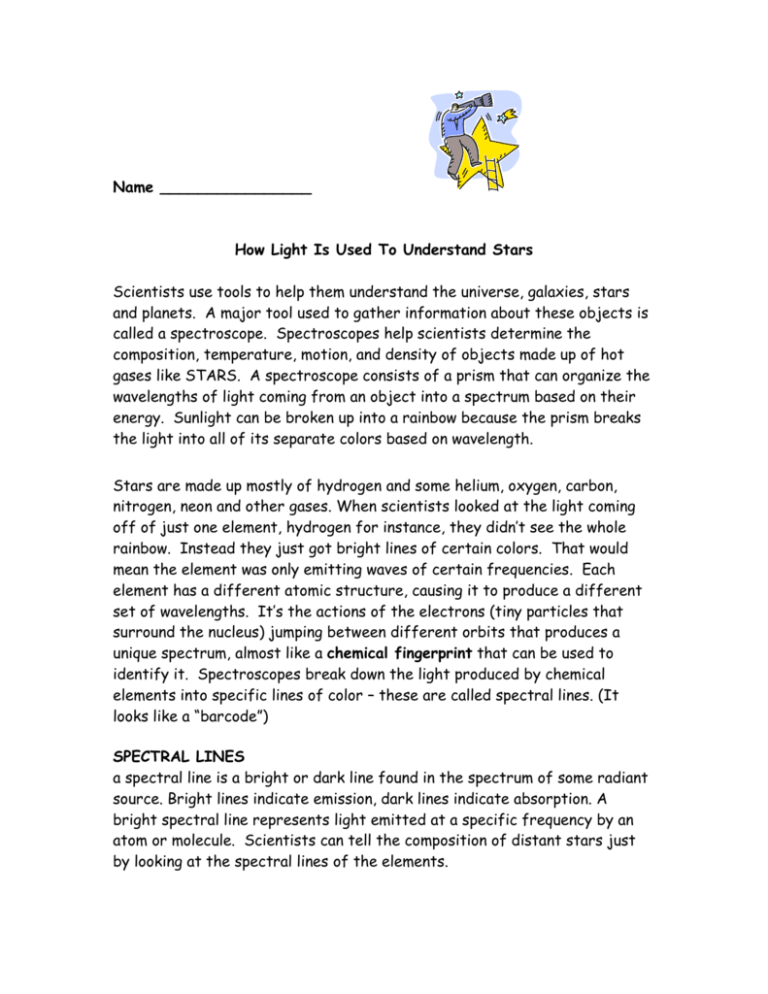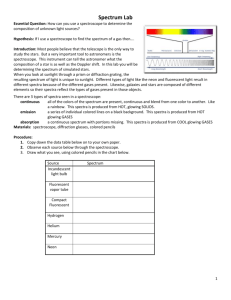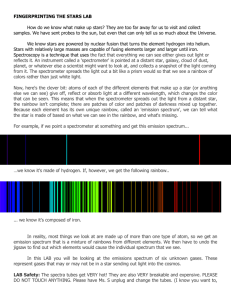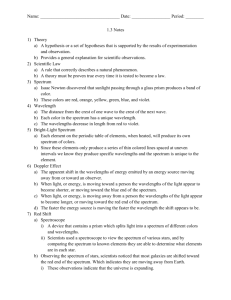How Light is Used to Understand Stars
advertisement

Name ________________ How Light Is Used To Understand Stars Scientists use tools to help them understand the universe, galaxies, stars and planets. A major tool used to gather information about these objects is called a spectroscope. Spectroscopes help scientists determine the composition, temperature, motion, and density of objects made up of hot gases like STARS. A spectroscope consists of a prism that can organize the wavelengths of light coming from an object into a spectrum based on their energy. Sunlight can be broken up into a rainbow because the prism breaks the light into all of its separate colors based on wavelength. Stars are made up mostly of hydrogen and some helium, oxygen, carbon, nitrogen, neon and other gases. When scientists looked at the light coming off of just one element, hydrogen for instance, they didn’t see the whole rainbow. Instead they just got bright lines of certain colors. That would mean the element was only emitting waves of certain frequencies. Each element has a different atomic structure, causing it to produce a different set of wavelengths. It’s the actions of the electrons (tiny particles that surround the nucleus) jumping between different orbits that produces a unique spectrum, almost like a chemical fingerprint that can be used to identify it. Spectroscopes break down the light produced by chemical elements into specific lines of color – these are called spectral lines. (It looks like a “barcode”) SPECTRAL LINES a spectral line is a bright or dark line found in the spectrum of some radiant source. Bright lines indicate emission, dark lines indicate absorption. A bright spectral line represents light emitted at a specific frequency by an atom or molecule. Scientists can tell the composition of distant stars just by looking at the spectral lines of the elements. CONTINUOUS SPECTRUM A continuous spectrum is a spectrum of emitted light that contains all wavelengths of the colors that compose white light (all the colors of the rainbow blended next to each other in a band - red, orange, yellow, green, blue, indigo, violet, from long to short wavelength). Bright-Line Emission Spectrum Specific gases send out light in only certain wavelengths. This is called a bright line spectrum - bright lines of color on top of a black background given off by the specific gases in stars. Each element always produces the same spectrum. Using the Spectroscope 1. Do not touch the gas emission tubes – they are very hot. 2. Keeping the spectroscope perpendicular to the source, look through the eyepiece. Align the slit with the light source. 3. When the slit is properly aligned, examine the spectrum through the spectroscope. 4. The spectrum is displayed on a wavelength scale inside the spectroscope, to the right of the slit. The numbers on the scale mark hundreds of nanometers. When measuring an emission spectrum, record the wavelengths and colors of the individual lines. A bright line spectrum with a blue line at about 445 nm, a green line at 525 nm, and a red line at 635 nm. Directions Using colored pencils, fill in each box with the spectrum that you observe in the lab. Be sure to place each color, line, and boundary at the proper unit from the spectroscope. │││4│││││││││5│││││││││6│││││││││7││││ Light Bulb Hydrogen Helium Discussion 1. What does the spectroscope do? ______________________________ _________________________________________________________ _________________________________________________________ 2. What did you see when you looked at the white light? ______________ _________________________________________________________ 3. Explain why this is called a Continuous Spectrum. _________________ _________________________________________________________ _________________________________________________________ 4. What other object emits visible light in a continuous spectrum? (Hint: We see the light as white light until it is separated by wavelength when it travels into different substances – prism, water) ___________________ _________________________________________________________ 5. What did you see when you looked at the two gases? _______________ _________________________________________________________ _________________________________________________________ 6. Why are there only certain bright lines or spectral lines when you look at the spectra from different gases? Is this gas emitting light of all wavelengths? ______________________________________________ _________________________________________________________ _________________________________________________________ 7. Explain how scientists can identify the elements in a star just by looking at the spectral lines. _________________________________________ _________________________________________________________ _________________________________________________________ _________________________________________________________









